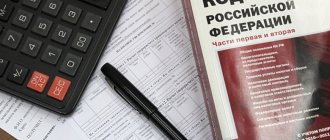How is personal property tax calculated for 2022: basic principles
Indeed, the property tax of Russian citizens is calculated by default by inspectors of the Federal Tax Service, and notifications containing the amount to be transferred to the budget are sent to the addresses of property owners.
But it is always useful for the taxpayer to verify the correctness of the calculations presented by the tax authorities. Since 2015, this tax has been calculated on the basis of the cadastral price of the property (if it is established in the territory where the property is located), while previously it was calculated based on another indicator - inventory value. The fundamental difference between the cadastral price and the inventory value is the proximity of the former to market prices for real estate. The more expensive the housing, the more tax is now paid to the budget for it.
The objects of taxation in this case may be (Article 401 of the Tax Code of the Russian Federation):
- residential buildings (including country houses);
- apartments;
- rooms;
- garages;
- parking spaces;
- buildings under construction;
- other types of real estate owned by citizens.
When calculating tax for 2022, the following indicators are used:
- cadastral price of real estate (calculated by the Federal Cadastre Service, Cadastral Chamber, after which the data is transferred to Rosreestr);
- rates established for the cadastral price (their value is determined by municipal authorities taking into account the norms of Article 406 of the Tax Code of the Russian Federation);
- deflator coefficient (determined by the Ministry of Economic Development of the Russian Federation);
- deductible area of the apartment to reduce the tax base, or deduction (also determined by municipal authorities taking into account the norms of Article 403 of the Tax Code of the Russian Federation);
- benefits (established by Article 407 of the Tax Code of the Russian Federation);
- reduction coefficients (taken into account during the first three years from the beginning of application of the tax calculation procedure based on the cadastral value).
As of January 1, 2020, property tax for individuals is no longer calculated based on inventory value (Law “On Amendments” dated October 4, 2014 No. 284-FZ).
If you have access to ConsultantPlus, check whether the tax authorities calculated your property tax from the cadastral value correctly. If you don't have access, get trial of online legal access.
Let's study in more detail how to use all these indicators in practice.
Taxation of a plot of land and a house on this plot - is there a difference?
According to paragraph 1 of Article 389 of the Tax Code of the Russian Federation, land plots, including those provided for individual housing construction, are objects for collecting land tax.
In turn, a residential building built on such a plot is recognized as the property of a citizen. In view of this, on the basis of paragraph 1 of Article 401 of the Tax Code of the Russian Federation, the house is subject to property tax.
Thus, the difference in the taxation of land for individual housing construction and a house located on this site is that different taxes are charged on their value. At the same time, different calculation methods have been established for land tax and property tax for individuals.
Reference! The land tax for individual housing construction is calculated based on the cadastral value of the land. And for a residential building, the payment is calculated as a percentage of the cadastral (or inventory) value of the property.
Formula for calculating property tax for individuals
In order to calculate the payment of the Tax Code of the Russian Federation, a formula has been established that has the following form:
H = (H1 – H2) × K + H2,
where: N is the amount of tax payable;
N1 - the nominal amount of tax, determined taking into account only the cadastral price of the object, the rate established for it and the deduction;
N2 - the nominal value of the tax, calculated taking into account only the inventory value of the apartment, the rate, as well as the deflator coefficient and has 2 definition options:
- As the amount calculated to be paid for this object for the last year of using the procedure for calculating the base from the inventory value. It can be applied both from the calculation for 2015 (and then will coincide with option 2 of the N2 calculation), and from later years, depending on the year from which the subject of the Russian Federation fulfilled all the conditions for calculating tax on the cadastral value provided for in paragraph 1 tbsp. 402 of the Tax Code of the Russian Federation.
- As the amount of tax calculated for 2014 in accordance with the procedure established by the expired Law of the Russian Federation “On taxes on property of individuals” dated December 9, 1991 No. 2003-I. This calculation is applicable for calculating tax on cadastral value starting from 2015.
K is a reduction factor, consistently increasing by 0.2 annually during the first 3 years of the beginning of the application of the calculation from the cadastral value, thus amounting to from 0.2 (in 1 year) to 0.6 (in 3 year). Starting from the 4th year, the reduction factor does not participate in tax calculations.
When calculating the tax for 2022, reducing coefficients were used (see Information from the Federal Tax Service dated September 23, 2021): 0.2 - for 10 regions (Altai Republic, Crimea, Altai and Primorsky Territories, Volgograd, Irkutsk, Kurgan, Sverdlovsk, Tomsk regions, Chukotka Autonomous Okrug), where from 2022 the cadastral value is used as the tax base for the first year; 0.4 – for four regions (Republics of Dagestan and North Ossetia - Alania, Krasnoyarsk Territory, Smolensk Region), where the cadastral value is used as the tax base for the second year; 0.6 – for seven regions (Perm region, Kaluga, Lipetsk, Rostov, Saratov, Tyumen, Ulyanovsk regions), where the cadastral value is used as the tax base for the third year.
Let's look at an example. Let's agree that:
- we pay tax for 2022 from the cadastral value;
- the tax is calculated from the cadastral value starting from 2018;
- we live in the Lipetsk region;
- We do not have tax benefits under Art. 407 Tax Code of the Russian Federation;
- we have an apartment of 70 sq. m, its cadastral value is 3,000,000 rubles, and its inventory value is 300,000 rubles.
The tax rate for the cadastral price of property established in the city is 0.1% for objects with a value below 10 million rubles.
For inventory value, the rate that is established at the federal level is used, due to the absence of a regulating municipal regulatory legal act. It is 0.1% if the property, taking into account the deflator, costs less than RUB 500,000. (Subclause 2, Clause 6, Article 406 of the Tax Code of the Russian Federation).
The deflator established for 2022 (the last year of application of the calculation from inventory value) is 1.425 (Order of the Ministry of Economic Development of Russia dated November 3, 2016 No. 698).
Property tax deduction for apartments - 20 sq. m. The one established at the federal level is used, due to the lack of a regulating municipal normative legal act (clauses 3, 7 of Article 403 of the Tax Code of the Russian Federation).
The reduction factor for 2022 is 0.6 (clause 8 of Article 408 of the Tax Code of the Russian Federation).
To calculate the H1 indicator:
1. We determine the value of the cadastral tax base, taking into account the deduction (all calculated data are rounded to the nearest ruble).
In accordance with paragraph 3 of Art. 403 of the Tax Code of the Russian Federation, it is equal to the cadastral value reduced by the cadastral value of 20 square meters. m of living space. Thus, we:
- Find the cost of 1 sq. m of living space: 3,000,000 / 70 sq. m = 42,857 rub.
- Based on the cadastral value of 1 sq. m, calculate the cost of 20 sq. m of living space: RUB 857,140.
- We subtract from the full cadastral value of housing (3,000,000 rubles) the resulting figure (857,140 rubles):
3,000,000 – 857,140 = 2,142,860 rubles.
2. We multiply this amount by the rate determined for the cadastral value (0.1%). The value of H1 will be 2,143 rubles.
Indicator N2 is equal to the amount of property tax calculated for 2017 based on inventory value:
1. We have a tax base of 300,000 rubles.
2. Multiply it by the deflator coefficient (1.425) and get 427,500 rubles.
This means that we can apply a rate of 0.1% when determining the H2 tax (Article 406 of the Tax Code of the Russian Federation). Multiplying the inventory tax base by this rate, we obtain the H2 indicator equal to 428 rubles.
Subtract indicator H2 from H1:
2,143 – 428 = 1,715 rubles.
We multiply the result by 0.6 (reducing factor for the third year of tax calculation from the cadastral value in accordance with Article 408 of the Tax Code of the Russian Federation), we get 1,029 rubles. We add the H2 indicator to it - and we get 1,457 rubles. This is the H indicator, that is, the tax that must be paid to the budget.
If it turns out that H1 is less than H2, a tax must be paid to the budget, which is equal to the H1 indicator (clause 9 of Article 408 of the Tax Code of the Russian Federation).
If a subject of the Russian Federation did not decide to charge tax on the cadastral value and did not approve this value at the beginning of 2016 (i.e., did not fulfill the conditions provided for in paragraph 1 of Article 402 of the Tax Code of the Russian Federation), it can begin to apply such a calculation from the beginning any year, from 2017 to 2022, and then the calculation of the H2 indicator will be made based on the inventory value multiplied by the deflator coefficient established for the last year of application of the tax calculation from the inventory value and the tax rate.
What to do if the Federal Tax Service employees calculated the tax payable incorrectly? Find out the answer to this question by getting trial access to the ConsultantPlus system for free.
You can check the correctness of property tax calculations using the calculator located on the website of the Federal Tax Service of the Russian Federation.
Tax rate for different regions
Despite the fact that the Tax Code of the Russian Federation sets specific rates for types of land, Tax Code norms allow local authorities to set other rates. So, in addition to the fact that deputies have the right to reduce rates, according to paragraph 2 of Article 394 of the Tax Code of the Russian Federation, they can accept different rates depending on:
- categories of land;
- permitted type of use;
- location.
In order to find out the level of the tax rate in a particular locality, you should familiarize yourself with the decision of city or rural deputies approving the provisions for collecting land tax (or the law of federal cities).
At the same time, for the convenience of taxpayers, a service for searching regulatory legal acts in the field of property taxation has been posted on the official website of the Federal Tax Service of Russia. To search, just enter the tax name and city.
For example, in Moscow the rate is 0.1%, and for St. Petersburg – 0.01%.
Important! If 10 years have passed since the acquisition of a land plot for individual housing construction and the corresponding registration of the right, then the rate is doubled until the moment when the right to the built house is registered.
Results
Since 2015, property tax for citizens of the Russian Federation has been calculated taking into account the cadastral price of the property, if all the conditions for this have been met in the corresponding region of the Russian Federation (a law has been adopted and the cadastral value has been approved on an object-by-object basis). In order to mitigate the increase in the tax burden on payers, the formula for calculating tax for 2015–2020 takes into account indicators such as inventory value, rates on it, and a deflator coefficient. Further, the tax will be calculated without using indicators that reduce the amount of tax.
You can familiarize yourself with other nuances of paying property tax in this article .
You can apply for a property tax benefit or report privileged property at any tax office. Read more about this here.
Sources: Tax Code of the Russian Federation
You can find more complete information on the topic in ConsultantPlus. Free trial access to the system for 2 days.
Preferential categories of citizens
Citizens belonging to certain social groups are granted an exemption from paying land tax up to 600 square meters. m. If a plot of land turns out to be more than the specified limit, then only the amount of the excess is subject to taxation.
In accordance with paragraph 5 of Article 391 of the Tax Code of the Russian Federation, citizens entitled to preferences include:
- Heroes of the USSR.
- Heroes of the Russian Federation.
- Veterans and disabled people of the Second World War and military operations.
- Full Knights of the Order of Glory.
- Disabled since childhood.
- Disabled people of groups I and II.
- Persons who participated in nuclear weapons testing, as well as those who became disabled as a result.
- Liquidators of the consequences of the Chernobyl nuclear power plant.
- Pensioners.
At the same time, paragraph 1 of Article 395 of the Tax Code of the Russian Federation provides for categories of payers who are completely exempt from paying tax.
Among the citizens in this list, only indigenous peoples of Siberia, the North and the Far East are named. The condition for release is the exploitation of the plots in order to preserve the traditional way of life and crafts.
Attention! The indication in the provisions of the Tax Code of the Russian Federation of preferential categories of persons is not exhaustive. Thus, by laws of the constituent entities of the federation or decisions of local deputies at the level of a particular city, village or other locality, additional benefits can be introduced.
For example, in Moscow, subparagraph 14 of paragraph 1 of Article 3.1 of the Law “On Land Tax” additionally establishes that Heroes of the USSR, the Russian Federation, Socialist Labor and full holders of the Orders of Glory, Labor Glory and “For Service to the Motherland in the Armed Forces of the USSR” are completely exempt from obligation to pay land tax on one plot.
In addition, the norms of paragraph 2 of Article 3.1 of the said Law allow certain categories of citizens to reduce the tax base not only by 600 square meters. m, but also an additional 1 million rubles.
Thus, in order to accurately determine which citizens are entitled to benefits, as well as the amount of benefits, one should refer to the regulations in force in a particular locality.
Determining the tax on a residential building - who does it?
The tax based on the cadastral value of the house is determined by the tax authorities. Where do they get the final numbers? Firstly, through interdepartmental cooperation, tax authorities receive data from Rosreestr on registered real estate. Each residential building registered in the cadastral register has its own cadastral value, that is, an assessment. The assessment of private houses is carried out by specialized and authorized state enterprises. When determining the cadastral value, they use clear methods and algorithms.
Also, tax authorities receive data from other government agencies about whether you are a benefit recipient and what taxable objects you own.
After the tax base receives information about your property, tax officials will calculate the tax on a private house, taking into account the cadastral value (tax base), tax rates, deductions and benefits.
Procedure for paying tax notices
Individuals pay tax on the basis of a notification sent to them by the tax authorities. This document must arrive to the taxpayer no later than a month before the due date of payment.
There are several ways to send a notification:
- delivery in person with the obligatory receipt of a receipt;
- by registered mail;
- to the taxpayer’s personal account.
If the notification does not arrive 30 days before the tax payment date, the citizen is recommended to independently contact the tax authorities in order to receive it.
The notice must contain the following information:
- taxpayer data;
- information about the plot of land to which the payment relates;
- tax calculation taking into account the benefits due to the taxpayer;
- payment deadline.
Sometimes the notice calculates the tax incorrectly. This can happen in the absence of information from the tax authorities about the provision of benefits to a citizen or a change in the cadastral value of an individual housing construction site. In this case, you should submit an application to the tax authorities attached to the notification and intended for feedback.
However, it is recommended to pay the tax within the deadlines established by law. After considering the issue, it will be possible to recalculate the tax and transfer the overpaid amounts to future periods. If this is not done, there is a risk of penalties being charged. Proving their illegality can be quite difficult.
The tax is deposited into the account of the Federal Tax Service. You can do this in several ways:
- via Yandex money wallet;
- using electronic money WebMoney;
- via Qiwi wallet;
- through any bank branch.
In addition, for the convenience of clients, some credit institutions offer online payments through various accounts. However, you should not make payments through unverified sites or organizations, as there is a risk of fraud .
Amount of tax on individual housing construction
The tax on individual housing construction is a payment of federal and regional significance. The main law that regulates its payment, of course, is the Tax Code. The tax rate is set by regional authorities. It is determined taking into account the purpose of the land plot.
The Tax Code provides only maximum rates.
Regional authorities have the right to reduce this norm in the territories entrusted to them. Since the tax rate can be set independently by regional authorities, it is best to clarify its size in each specific case. The marginal rates for various types of land are presented in the table. (click to expand)
| Marginal tax rate | Categories of land subject to this rate |
| 0,3% | Lands under housing stock Plots intended for individual housing construction Lands intended for personal farming, gardening, summer cottages |
| 1,5% | Other land plots |
An example of tax calculation for shared ownership of land
Let's assume that the land plot for individual housing construction has two owners. The first one owns 2/5, and the second one owns 3/5 of the land area. The cadastral value as of January 1, 2016 was 987,000 rubles. The tax rate in the region is equal to the marginal one. It turns out that the tax is paid based on the rate for the individual housing construction site, equal to 0.3%.
The tax amount in accordance with the calculation rules will be equal to: (click to expand)
- For the first owner = 987,000 x 2/5 x 0.3% = 1,184.40 rubles.
- For the second owner = 987,000 x 3/5 x 0.3% = 1,776.60 rubles.
- The total amount of tax payable to the budget for the plot in question in 2016 is 2,961 rubles.
Procedure for notification and deadlines for paying tax on the cadastral value of a private/residential house
Each owner-taxpayer must be notified of the tax payment procedure. Notice will be sent by mail and/or electronically.
If you do not agree with the amount billed, or if the tax authorities did not take you into account as a benefit recipient, then you should contact your local Federal Tax Service. You may need to write an application for benefits and provide supporting documents.
Important: local authorities have the right to establish additional tax benefits and deductions, as well as exempt certain categories of citizens from paying taxes.
The tax on the cadastral value of a house is paid once a year - until December 1 of the year following the tax period.
If the house has not been owned for a whole year, but only for a few months (let’s assume ownership is registered in November), then the tax on a residential house will be calculated based on the calendar time of ownership. This takes into account the transfer of ownership. In this case, the amount of tax on the cadastral value of the house is reduced, and you pay only for the time you own the property, that is, not for the whole year, but for November and December.



